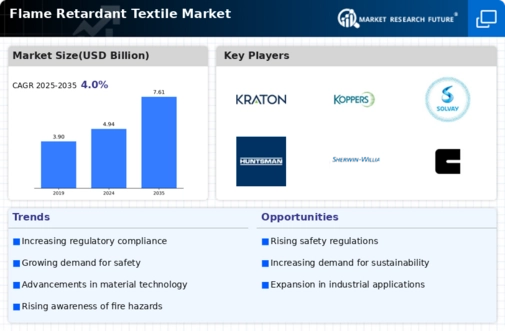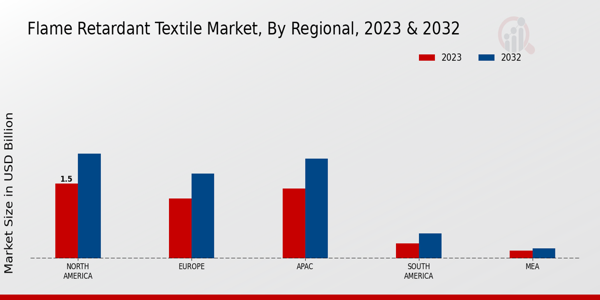Market Growth Projections
Increasing Safety Regulations
The Global Flame Retardant Textile Market Industry is experiencing growth driven by stringent safety regulations across various sectors, including construction, automotive, and aerospace. Governments worldwide are enforcing regulations that mandate the use of flame retardant textiles to enhance safety standards. For instance, the National Fire Protection Association (NFPA) has established codes that require flame-resistant materials in specific applications. This regulatory push is expected to significantly contribute to the market's expansion, with the industry projected to reach 4.94 USD Billion in 2024. As safety concerns continue to rise, compliance with these regulations will likely drive demand for flame retardant textiles.
Expansion of End-Use Industries
The expansion of end-use industries such as construction, healthcare, and hospitality is a crucial driver of the Global Flame Retardant Textile Market Industry. As these sectors grow, the demand for flame retardant textiles is expected to rise, particularly in applications where fire safety is paramount. For instance, the construction industry increasingly utilizes flame retardant materials in insulation and wall coverings to comply with safety regulations. Similarly, the healthcare sector employs flame retardant textiles in patient gowns and bedding to mitigate fire hazards. This broadening of applications across diverse industries is likely to support the market's growth, with expectations of reaching 7.61 USD Billion by 2035.
Rising Awareness of Fire Safety
There is a growing awareness of fire safety among consumers and industries, which is significantly influencing the Global Flame Retardant Textile Market Industry. Educational campaigns and high-profile fire incidents have heightened public consciousness regarding the importance of flame-resistant materials. This awareness is driving demand across various applications, including home textiles, workwear, and protective clothing. As consumers increasingly seek products that enhance safety, manufacturers are responding by incorporating flame retardant properties into their offerings. This shift is expected to contribute to the market's growth, with projections indicating a market size of 4.94 USD Billion in 2024, reflecting the increasing prioritization of fire safety.
Growing Demand from the Automotive Sector
The automotive sector is a significant driver of the Global Flame Retardant Textile Market Industry, as manufacturers increasingly prioritize passenger safety. Flame retardant textiles are essential in vehicle interiors, where they are used in upholstery, carpets, and headliners to reduce fire risks. With the automotive industry projected to grow substantially, the demand for flame retardant materials is expected to rise correspondingly. This trend is underscored by the anticipated market value of 7.61 USD Billion by 2035, indicating a robust growth potential. As automotive safety standards evolve, the incorporation of flame retardant textiles will likely become a standard practice, further boosting market demand.
Technological Advancements in Textile Manufacturing
Technological innovations in textile manufacturing are propelling the Global Flame Retardant Textile Market Industry forward. Advanced production techniques, such as nanotechnology and chemical treatments, are enhancing the effectiveness of flame retardant properties in textiles. These innovations not only improve the performance of flame retardant fabrics but also expand their applications across various industries. For example, the integration of smart textiles with flame retardant capabilities is gaining traction in sectors like military and protective clothing. As these technologies evolve, they are expected to contribute to a compound annual growth rate (CAGR) of 4.01% from 2025 to 2035, further solidifying the market's growth trajectory.















